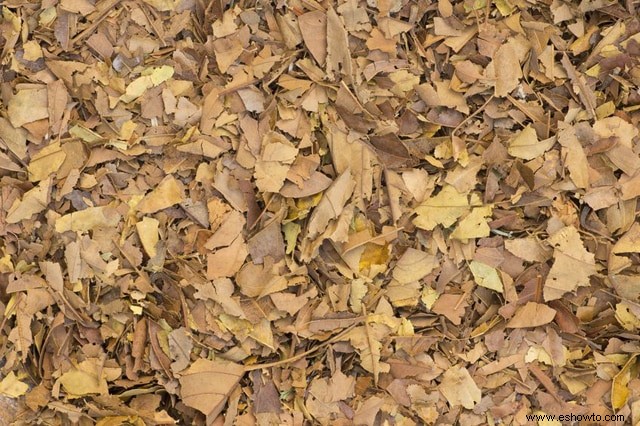Entonces, ¿qué es el mantillo y por qué lo usamos? Sé que he esparcido el material alrededor de mi huerto o parterres de flores sin saber realmente su propósito, solo me gusta su aspecto.
En verdad, el mantillo es muy importante para la salud de su jardín. Ayuda a retener la humedad del suelo, controla el crecimiento de malezas, previene la erosión del suelo y mantiene el suelo saludable en general. El mantillo es algo bastante increíble, y cualquier jardín o patio que no lo utilice definitivamente se lo está perdiendo.
Sin embargo, ¿qué es el mantillo? Esa es una pregunta complicada debido al hecho de que hay tantas variaciones diferentes
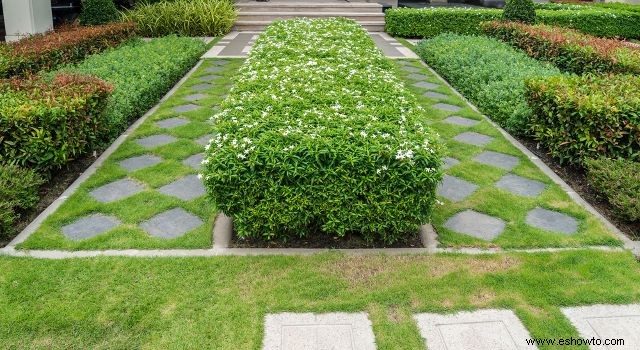
TIPOS DE ACOLCHADO
Todos los diferentes tipos de mantillo no existen solo por razones estéticas. Algunos retienen mejor la humedad mientras que otros mantienen el suelo saludable. El tipo de mantillo que necesita puede variar mucho según cuál sea su objetivo con el área en la que lo está utilizando. Para averiguarlo, primero deberá aprender qué es cada tipo de mantillo.
MANTILLA DE JARDÍN
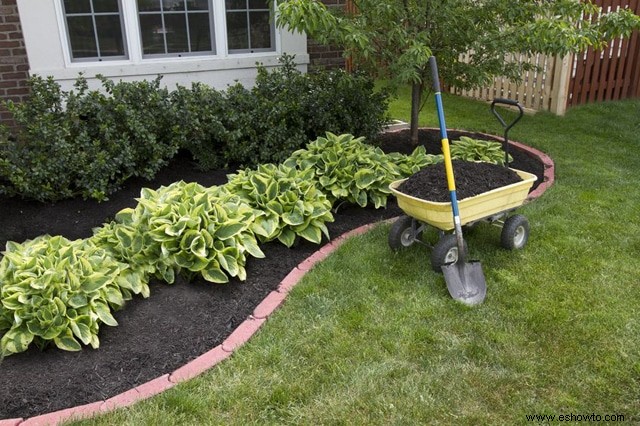
Mantillo es un término general para casi cualquier tipo de material que usaría sobre el suelo en el paisajismo. El mantillo de jardín, específicamente, sería el tipo que usa en su jardín. Esto puede incluir prácticamente cualquier tipo de mantillo, pero definitivamente algunos funcionan mejor que otros. Algunos también se ven mejor que otros.
PAJILLA DE CAUCHO
¿Quiere hacer su parte ayudando a reducir, reutilizar y reciclar? Si es así, el mantillo de caucho podría ser algo bueno para usted. Si bien puede funcionar en una situación de cultivo de plantas, tal vez cumpla su mejor propósito como material para pisos al aire libre.
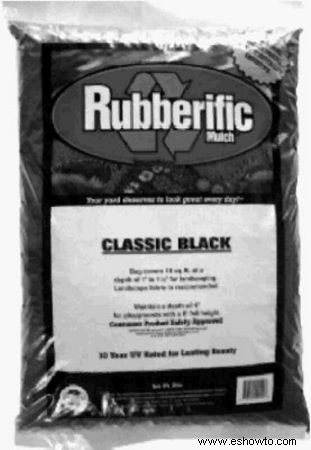
El mantillo de caucho está hecho de caucho de llantas que se han cortado en pepitas o caucho que se raspó de llantas de semirremolque antes de recauchutarlas, lo que se denomina pulido. Aunque no son necesariamente orgánicos, sirven para algunos propósitos orgánicos.
Por ejemplo, el mantillo de caucho tiene la capacidad única de aislar el suelo del calor en comparación con los mantillos de madera. Además, dado que el caucho es un material no poroso, no se pierde humedad a medida que avanza a través de la capa de mantillo hacia el suelo.
En cuanto a los usos ajenos a la jardinería, el mantillo de caucho se ha ganado un gran respeto como material apto para parques infantiles. En lugar de usar mantillo de madera en el piso del patio de recreo, a menudo se usa mantillo de goma, que puede hacer que el área sea más segura para que los niños jueguen. Gracias a la elasticidad asociada al caucho, utilizar este material para amortiguar caídas es mejor que otros tipos de suelos de exterior.
Ventajas: | Contras: |
PAJO DE CORTEZA
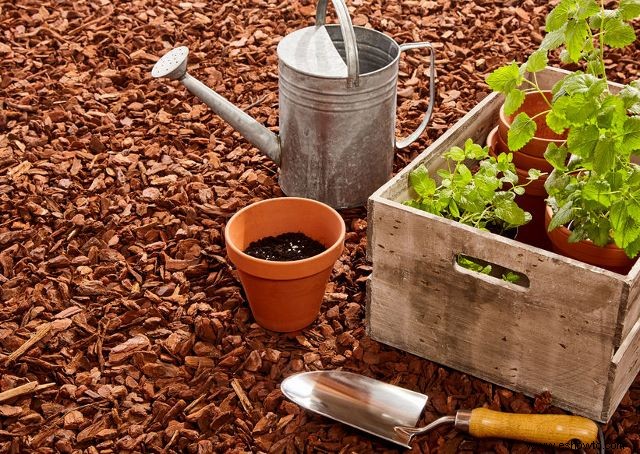
El mantillo de corteza, como su nombre lo indica, proviene de la corteza de los árboles. Más concretamente, es la corteza que se ha cosechado de varias coníferas, como pinos y abetos. El mantillo de corteza definitivamente es estéticamente agradable. Las grandes astillas de corteza llaman bastante la atención y también tienen algunos buenos beneficios para el crecimiento.
Por ejemplo, no permite que la humedad se evapore muy bien, lo que ayuda a conservar las cosas. Además, a medida que envejece, puede devolver nutrientes al suelo. Sin embargo, definitivamente hay algunas desventajas que funcionan contra el mantillo de corteza. Es bastante ligero, por lo que puede moverse con el viento o la lluvia.
Además, puede ser algo frágil y propenso a astillarse. Puede obtener mantillo de corteza en formato triturado, si las astillas no son de su estilo, lo que podría adaptarse mejor a sus propósitos y tiene sus propios beneficios. Puede retener la humedad incluso mejor que el chip y es más pequeño, por lo que puede descomponerse más rápido para ayudar a limpiar la tierra.
Ventajas: | Contras: |
MULCH DE MADERA DURA
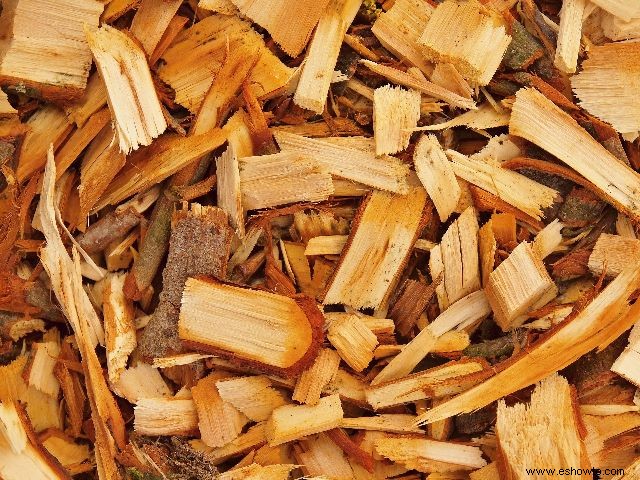
El mantillo de madera dura es potencialmente muy económico. Dado que se compone básicamente de desechos de trabajos de poda de árboles y cosas viejas de madera, encontrar el material que se ha triturado en mantillo puede ser tan simple como hacer algunas llamadas y llevárselo de forma gratuita. Por supuesto, su millaje en esto puede variar.
En jardines y otras situaciones de paisajismo, las astillas de madera dura se pueden usar alrededor de plantas que no requieren mucho ácido, ya que el material se descompone en una forma alcalina con el tiempo. Las plantas que necesitan más ácido podrían requerir algún fertilizante especial que aumente el ácido en ese caso.
Supongo que eso es un poco positivo y negativo, dependiendo de las plantas que estés usando. Otra desventaja de usar mantillo de madera dura es cómo cambia con los años. Es propenso a volverse gris después de un tiempo, momento en el cual será necesario rastrillarlo y voltearlo. Esto también significa que no será tan bueno después de un par de años.
Además de eso, las astillas de madera dura son un excelente buffet para las termitas, por lo que no es recomendable tener mantillo de madera dura en un jardín que bordea su casa.
Ventajas: | Contras: |
HEMLOCK MULLH
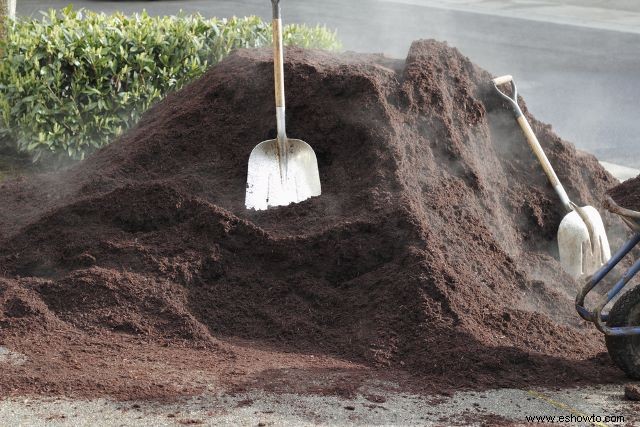
Los árboles de cicuta tienen mala reputación. Hay un poco de un caso de identidad equivocada involucrada con ellos, ya que muchas personas creen que usar su corteza o madera puede ser peligroso, ya que la cicuta es venenosa. Los árboles de cicuta, sin embargo, no son venenosos. La materia venenosa es un animal completamente diferente. Bueno, no un animal, sino un arbusto salvaje con hojas grandes y un tallo morado.
Es realmente una lástima que exista este estigma, porque el mantillo de cicuta es realmente fantástico. Es un mantillo de madera dura, por lo que tiene los mismos beneficios y problemas que otras maderas duras, pero también tiene algunas cualidades especiales. Parece que el árbol contiene una gran cantidad de taninos, y estos taninos evitan que los insectos se metan en la tierra y mastiquen las plantas. También es bastante agradable a la vista.
Ventajas: | Contras: |
MANTILLO DE HOJA
Es posible, y en realidad no es una mala idea, utilizar las hojas que se han caído de los árboles como mantillo. Esto no le cuesta absolutamente nada de dinero, no requiere mucho trabajo y funciona bastante bien. Sin embargo, hay un par de advertencias a tener en cuenta al usar hojas como mantillo.
Una vez que la naturaleza haya hecho lo suyo y haya hecho que todas las hojas caigan de sus árboles cuando llegue el otoño, tome su rastrillo y recójalas. Antes de usarlos como mantillo, primero deberá triturar las hojas. Esto se puede hacer con una trituradora, una cortadora de césped trituradora o un soplador de hojas que tenga una función de aspiración.
El uso de una capa de hojas demasiado gruesa puede tener algunos efectos negativos no deseados en el suelo, como evitar que el aire y el agua entren en él. Al mismo tiempo, también pueden retener demasiada humedad, lo que permite la posibilidad de problemas de pudrición y hongos.
Primero puede aplicar una capa delgada de hojas completas, pero triturar el resto antes de ponerlas en su suelo permitirá un mejor paso de aire y agua, asegurándose de que su suelo se mantenga tan saludable como sea necesario para que sus plantas prosperen. . Las hojas que no uses se pueden usar como abono para proyectos de jardinería en el futuro.
Ventajas: | Contras: |
PAJILLA DE VIDRIO
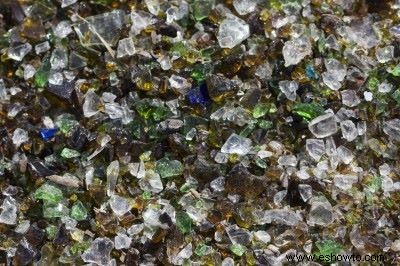
¿Sabía que el vidrio se puede usar como mantillo? El mantillo de vidrio, casi exclusivamente decorativo, está hecho de vidrio reciclado que se ha volteado para eliminar los bordes afilados. Se puede colocar prácticamente en cualquier lugar donde se puedan poner rocas o guijarros en un paisaje, pero tiene el efecto único de ser muy bonito. Suele estar formado por cristales de todo tipo de colores, creando un aspecto realmente incomparable.
Desafortunadamente, es un poco caro. Mucho más caro que cualquiera de los mantillos orgánicos, seguro. El uso de mantillo de vidrio para las plantas requiere plantas que puedan manejar suelo rocoso, y debe haber un poco de tela o plástico entre el vidrio y el suelo para evitar que el mantillo se hunda demasiado con el tiempo.
Ventajas: | Contras: |
MULCH DE ROCA DE LAVA
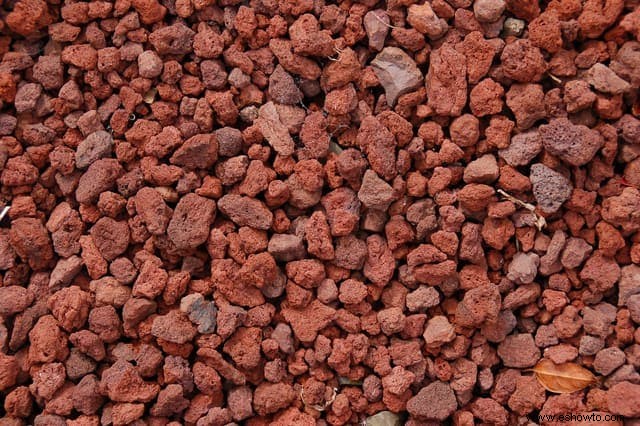
El mantillo de roca de lava, a veces llamado mantillo de piedra pómez, es bastante útil y funciona de manera similar al mantillo de caucho en el sentido de que permite el flujo adecuado de agua sin absorber nada. También como el caucho, la piedra de lava ayuda a que el suelo se mantenga caliente, aunque no de la misma manera. Mientras que el caucho sirve como aislante del calor, la roca de lava absorbe el calor durante el día y luego ayuda a las plantas manteniendo las cosas calientes durante la noche.
También es bueno para mantener la humedad y, con la ayuda de una barrera como tela o plástico debajo, puede evitar que las malas hierbas entren en su jardín. En el extremo opuesto del espectro, el material es bastante liviano, por lo que es posible que no se quede quieto, y es lo suficientemente resistente como para dañar su cortadora de césped, en caso de que algo termine en el jardín donde no se necesita.
Además, debe tener cuidado al usar roca de lava para verificarla de vez en cuando. El material puede acumularse entre las rocas mismas, lo que podría impedir que el aire y el agua lleguen al suelo correctamente.
PAJOTE ROJO
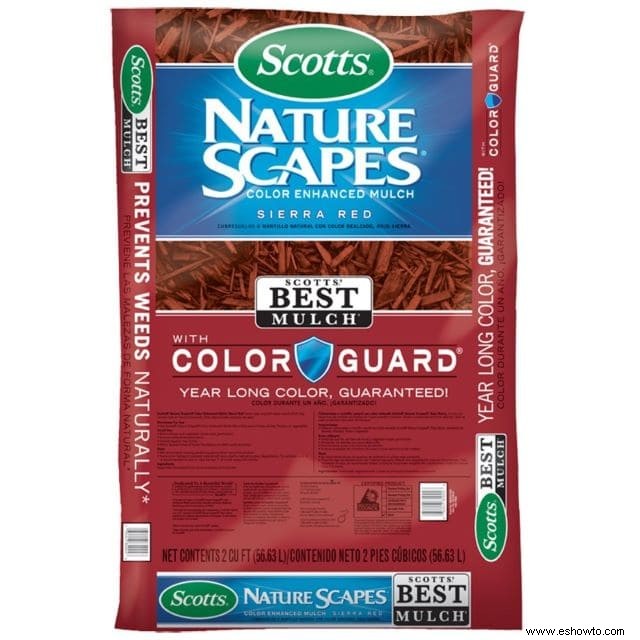
Es muy probable que hayas visto algo de mantillo rojo en tu vida. Es, si no pudieras decirlo, la cosa súper roja que a veces ves en el jardín de alguien o en el paisaje de un negocio. Claro, puede obtener mantillo rojo de forma natural, según el origen del material. Muchos tipos de mantillo de corteza pueden verse rojizos debido a que provienen de árboles de corteza roja, pero a menudo, el mantillo rojo que está viendo se ha teñido.
In a great many cases, red mulch has a similar origin to hardwood mulch, often coming from the leftover materials of construction jobs and such. Because of this, and because of some of the more unsavory materials which can be used as dyes, they’re often not recommended for growing situations, as red mulch can potentially leak harmful chemicals into the ground, causing damage to nearby plants.
ENVIRO MULCH
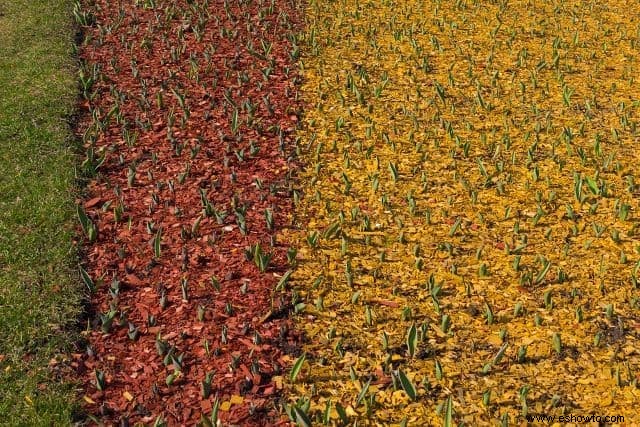
If you’ve ever heard the term enviro mulch and weren’t sure what it meant, you’re not alone. This isn’t a term thrown around too often, but it’s something which does exist and is rather specific. Enviro mulch is basically the same as any other sort of wood mulch, such as bark or hardwood, for instance, but it is exclusively made up of recycled materials, be that old wood, cardboard boxes, paper, or whatever else out there started out as a tree.
Just as with bark or hardwood, it is often found dyed into various shades, and, just as with its counterparts, it carries the same positive and negative benefits, but this time you’re certainly doing your part by giving new life to material which may have otherwise been wasted, left rotting away in a landfill or something.
GRASS MULCH
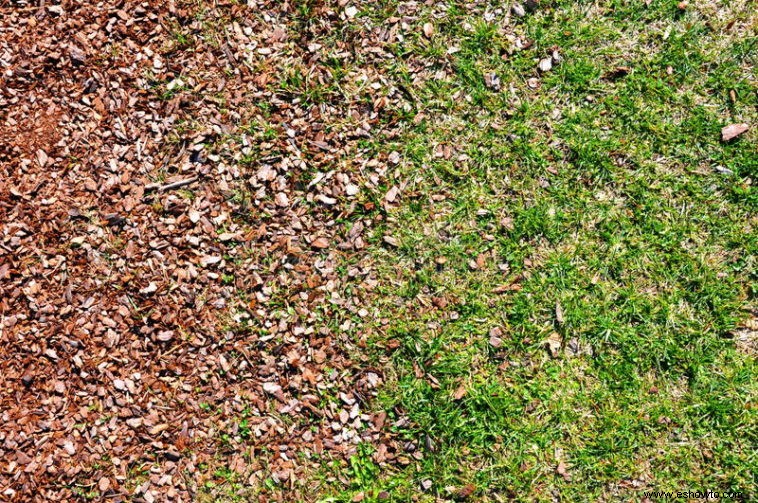
One of the most convenient and readily available materials you can use for mulch is your own grass clippings. Everyone has access to it since it can be pulled right out of your lawnmower’s clipping bag. It’s a great opportunity to take something you would normally throw away and put it to some good use out in the garden.
Grass is a great material to use for mulch since it can be spread in a thin layer that will eventually turn into usable soil. Plus, there is never a shortage in the supply as long as you are regularly cutting the lawn. However, it is important that you don’t use grass that has been treated with any pesticides since these will break down over time and seep into the new soil.
Pros: | Cons: |
COCOA CHIP MULCH
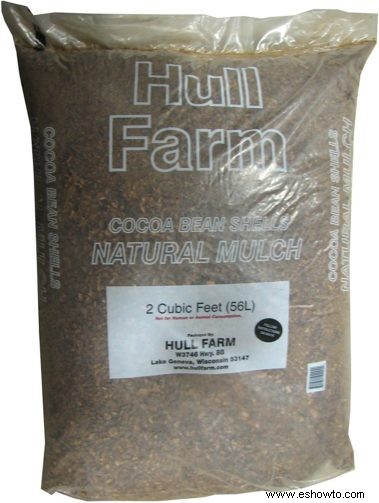
The husks of cocoa beans make a great mulch for your garden and have a lot of important benefits. They contain nutrients like phosphate and nitrogen, which help them enrich the soil and create a more productive environment for plants. They also have a pleasing look that is both unique and completely organic.
One of the reasons cocoa chips make such a great mulch is that they can be a natural weed eliminator. However, they can also be incredibly toxic to animals and other wildlife. Always be certain that no animals are getting into your yard and looking for food if you are going to use them.
Pros: | Cons: |
What Is Mulch Used for and What Does It Do?
Mulch is one of the most useful tools in a gardener’s belt when it comes to promoting a healthy environment for plant growth. It has a wide variety of uses and benefits and can be a real help when it comes to the look of your backyard or garden. With so many options as far as types, colors, and textures, you can keep the soil looking nice while also priming it to be as fertile as possible.
Staving Off Soil Erosion
Perhaps the most important benefit of using mulch is the fact that it can help keep your soil healthy. Since organic mulch is meant to break down over time, its chemical makeup can enhance the soil and feed it. Many organic mulches contain vital nutrients like nitrogen, potash, and phosphate.
Mulch also helps mitigate soil erosion by providing a layer of protection from the elements. Wind, rain, snow, and other weather conditions can cause your soil to break down and become unviable. By using mulch, you can ensure that the soil underneath will remain healthy and safe for your backyard garden.
Weed Abatement
Any home gardener knows that weeds are one of the biggest annoyances to deal with. They can overgrow and choke other plants that you are trying to keep alive and productive. They also grow everywhere and can become a pain to pull all the time.
By covering the soil with a layer of mulch, you can stop weeds before they even start to penetrate the surface. Mulch keeps light from reaching the soil and helps prevent the growth of weeds before it begins. By laying some down in areas you want to keep clear, you can create a zone where nothing will grow if you don’t want it to.
Moisture Retention
Mulch can also help seal in moisture in the soil, which helps keep it healthy and ideal for the plants that you want to thrive. By covering an area with mulch, the water in the soil is protected from evaporation and will stay in the ground to feed the surrounding plant life. This prevents the need for excess watering when the conditions are hot and dry.
Mulch creates an extra layer of protection for the soil, so it can retain up to 80% of the moisture that is put into it. This helps save water during hotter months and makes your entire garden lower maintenance in general. The more water that stays in the soil, the less you will have to put in.
Aesthetics
Mulch adds a layer of protection that is not only effective but can also be incredibly beautiful. Since it comes in so many different textures and colors, it is a wonderful tool for planning out intricate landscape design. It can be used to demarcate paths and specific areas, and there is almost no end to the possibilities and design choices you can make.
Mulch can also help cover up soil or grass that has been damaged by the sun or lack of care. It is a great, low maintenance solution to the problem of what to do with dry, brown grass or dusty, unappealing soil. If you want to clean up your yard without a whole lot of extra maintenance and work, mulch could be your best option.
WHAT IS USED TO DYE MULCH?
Certain mulches have the capability of being dyed. It isn’t unusual to see red, brown, black and even green mulch from time to time. Is dying the mulch safe for the plants on which it will be used? Are there certain dying methods which may be better than others? Is there a benefit to using a dyed mulch over one which is more natural? Let’s take a look.
Vegetable-Based Dye
True to their name, vegetable-based dyes are created using different types of plants, just as dyes were in olden times. These are great for any type of garden, because if there is any sort of leaching going on with the materials used to dye the mulch, it’s not going to be a bad thing for your plants.
Iron-Oxide-Based Dye
Since red is a pretty popular color out there, mulches dyed using iron-oxide-based dyes are pretty common. It may, in fact, by the most common type of dye. It is created by combining iron and oxygen, and using the resulting compound to color the mulch. If you weren’t aware, iron-oxide is basically rust, hence the rust-like color of the mulch.
While the runoff from this does go into the soil, it isn’t necessarily a bad thing. It just means there’s more iron for your plants, which can actually be a benefit to certain varieties of plant which may need a little more metal in their systems.
Carbon-Based Dye
Any mulch which has been dyed black was likely dyed using a carbon-based dye. This color is acquired by using carbon black, which is the byproduct of incomplete combustion of a number of items. Many of the sources aren’t exactly edible or good for plants, but one source is:vegetable oil.
Using carbon black produced from vegetable oil, mulches can be dyed and not have any sort of negative impact on the soil beneath them. This is especially important if it’s being used as mulch around plants which provide food, such as those in a garden.
Many countries use carbon black for even more things, such as the coloring of food packaging and trays. When mulch dyed with carbon black breaks down, it releases carbon into the soil, pretty much in the same fashion as burying charcoal.
Dying Mulch Yourself
Is your mulch looking a little under the weather? Spruce it up by giving it a little of that color it deserves. This process is moderately new. In general, most people will throw away their dull mulch and replace it with new good stuff, or just cover up the old with the new.
Doing the deed yourself isn’t especially difficult, but it does take some planning. First off, you need to choose your dye from one of the many available colors. In order to have the best effect, you should try to get a dye which is near the original color of your mulch in case you miss a spot or two.
If there is rain in the forecast, continue waiting a day or two for sometime when you’re sure to have clear skies and bright sun for at least six hours. Once you spray the dye onto your mulch, it’s going to need time to dry, and rain will just come in and mess up all of your hard work.
Obviously, dye is designed to last, so making sure it only goes where you want it to go is a big deal. If you’re dying mulch along a sidewalk or driveway, do whatever you can to keep it from getting onto those surfaces. This can be as simple as laying down a tarp or using sheets to cover plants and such.
Once you’re prepped and the area is protected, it’s time to mix the dye. It doesn’t take a lot. You’ll need a sprayer and the dye you’d like, then you just follow instructions. Spraying isn’t much work, either. All you have to do is keep your nozzle about six inches above the mulch, then spray as you work your back and forth. Keep your distance even in order to keep your color even.
WHICH TYPE OF MULCH TO USE FOR
Now that we’ve learned about most of the different types of mulch, the million-dollar question yet remains:Which mulch is the best mulch? You may as wonder where to use mulch. As with our previous discussions, this is complicated, but only because there are so many options which can work, and each comes with its own benefits and downfalls.
WEED CONTROL
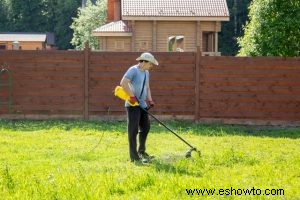 For the best results, you have to think of keeping weeds out of your garden and landscaping as a team effort. First applying a layer of either cardboard, newspaper or fabric works to keep light from getting to the soil itself, thus giving weeds the opportunity to thrive. No light means no weeds, in theory.
For the best results, you have to think of keeping weeds out of your garden and landscaping as a team effort. First applying a layer of either cardboard, newspaper or fabric works to keep light from getting to the soil itself, thus giving weeds the opportunity to thrive. No light means no weeds, in theory.
On top of that, an organic mulch is a great way to go. Using something like a hardwood or bark mulch helps with the moisture and such, as a good mulch should, but being organic, it’s more likely to invite critters to live inside it. These critters have the potential to skitter about and eat any weed seeds which may find their way into the mulch or soil. It takes a village to keep weeds out.
AROUND THE HOUSE
First and foremost, if you’re going to have mulch around the walls of your house, make sure it isn’t wood. Wood mulch just loves bringing in bugs of all varieties, which can end up in your home, if they’re too close. Most of the bugs which show up are just minor nuisances, but one, in particular, can have devastating effects on your home:termites.
Termites love wood, of course, so it would make sense they would be attracted to wood mulches. To combat this, stick to the non-wood organics, such as leaf mulch, or go the full inorganic route. Lava rocks make a great addition to landscaping around the home, especially if they are a contrasting color to the home itself. Using the right sort of mulch can make a home stand out, increasing its curb appeal dramatically.
DEEP MULCH GARDENING
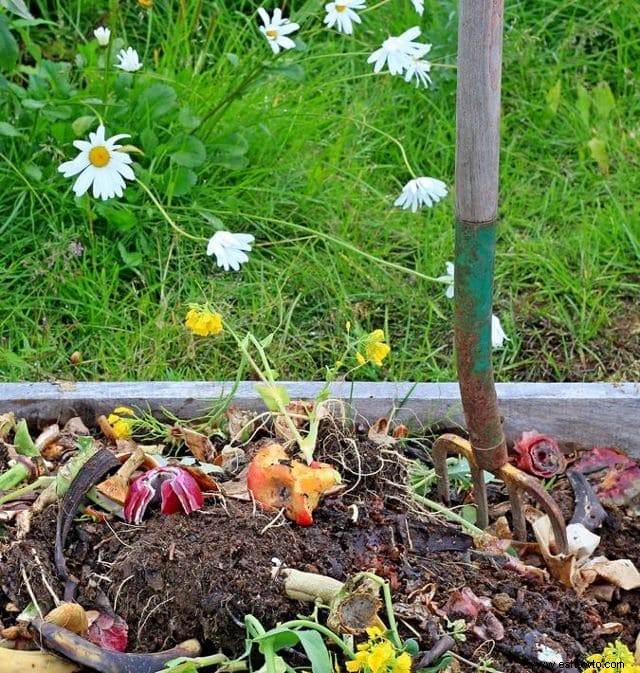
Deep mulch gardening, sometimes called sheet mulching, is almost like the Ronco of mulching, you can set it and forget it. Pick a spot in your yard in which you want to plant something and start piling on the materials. We’re talking pretty much anything organic you can think of. Straw, leaves, manure, cardboard, newspaper, whatever you have lying around which you don’t need and which started out as a plant.
The goal is to get it something like a foot tall, so it can work its mulch magic on the ground below. Deep-mulch gardening has the special ability to rejuvenate ground which has been compacted and may not be suitable for growing. By using this method, the ground begins to soften, and it leaches many nutrients from the mulch used on top.
Because of this goal, your best bet is to go with any sort of mulch, but the easier it is to break down, the better. You’re just going to need a whole lot of it, seeing as you want your pile to be about a foot tall. This is likely going to be the most difficult part. You can get out there and break up the ground a few times with the right tools, but finding enough material to get a foot of material over whichever size plot you intend to use can be something of a pain. Still, it’s worth it if you can work it out.
COMPOST VS. MULCH
This is a topic that has bugged me for years. What’s the difference between compost and mulch? Without ever having looked into it myself, I never quite understood, but they’re two completely different beasts which can work together to create the perfect garden.
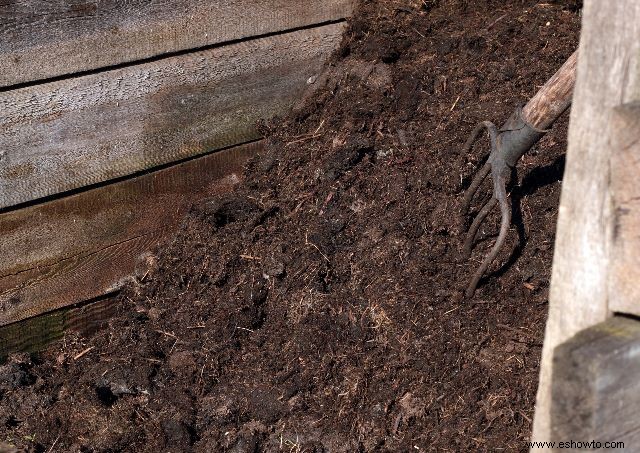
Compost is material teeming with bacteria and such after having been allowed to decompose in a controlled environment. Many people will use grass trimmings, manure and garbage to make it, often having allowed it to decompose in a bin or large pile in the yard.
Compost is typically mixed into the soil, giving it additional nutrients and such to help plants grow better than they may have with just using the soil. It can also be spread across the top of the soil as a mulch. Mulch, on the other hand, is only for the top of the soil and doesn’t necessarily serve to enhance the soil, so much as protect it.
Mulch keeps the soil at a good temperature, keeps weeds from growing, conserves water and generally looks nice. Compost doesn’t do any of that, it just makes the soil work better than it may have before. It isn’t a fertilizer, necessarily, though it does offer great nutrient-saving effects.
Mulch can also serve as this, to a degree, once it begins to decompose. This, of course, only applies to organic mulches such as bark, hardwood and leaf mulches, as opposed to any of the rubber or stone variety. When they decompose, they put their own nutrients into the ground, though still not to the extent of compost.
To have a truly remarkable gardening experience, make use of both compost and mulch, as these two go hand in hand to keep plants look fantastic and growing to new heights.
WHY MULCH?
I think it would be more prudent to find out why somebody wouldn’t mulch, rather than why someone should. The benefits of mulching are myriad, ranging from healthier soil with greater plant growth to simply looking fantastic. Whether your goal is to have a better harvest or to have the best yard on the block, mulch is the way to go in pretty much any situation.
With all the varieties out there, finding one which suits your situation perfectly can be a breeze. Many have similar properties, but each also has something the others do not. You can be environmentally friendly, you can do it all on your own, and you can do it for cheap, all while working to make your yard the envy of anyone who may see it.
WHY NOT MULCH?
Though the benefits are obvious, perhaps the downsides are not. Frankly, the benefits greatly outweigh any negatives, but they’re worth noting. Mulch provides a great home for bugs. This, as mentioned, can be good in some respects. They can eat at weed seeds to keep weeds from dealing with your plants. However, other bugs may find their way to your plant and start munching it up.
While some mulches help retain heat, others keep it from getting too deep into the ground. This is positive and a negative. While it can keep flowers from blooming early, it can also force them to bloom late, which isn’t usually a good thing.
The moisture-retaining properties of mulch can also be negative. Yes, keeping the ground moist is a great thing. Plants love it. Plants don’t love too much water, though, as it can begin to cause issues. If extraneous water is not allowed to evaporate, it can sit and begin to start causing the plant’s roots to rot, or allow for fungus to begin to form. These are bad things if you couldn’t tell.
Finally, there is the issue of blocking light. This is great for stopping weeds from growing, but if you’re attempting to plant something new, you’re going to need some of that light to get down into the soil in order to help the seeds germinate. No germination, no plant, no garden.
THE FINAL DIRT
Mulch is a great thing. Even with its downsides, it’s far more beneficial than other things you can do in your garden. Having mulch should, in theory, keep your plants grow stronger, your soil staying moister and weeds from growing and causing you problems.
In fact, mulch could potentially keep you from working more by maintaining proper soil health. All you’ll have to do with mulch is go out and rake it around every once in a while, and maybe replace it every few years, depending on the type you use.
All in all, don’t be afraid of mulch and don’t be afraid of what it can do to your garden. So long as you take care of it, mulch is going to be the greatest thing you can do to your landscape. What did you think of this list? Did it help answer any questions you had about mulch? If so, or if you had any further questions, please comment and share below!
*You might also like: Liquid Lawn Fertilizer vs. Granular:Which is the Best for Your Lawn?


